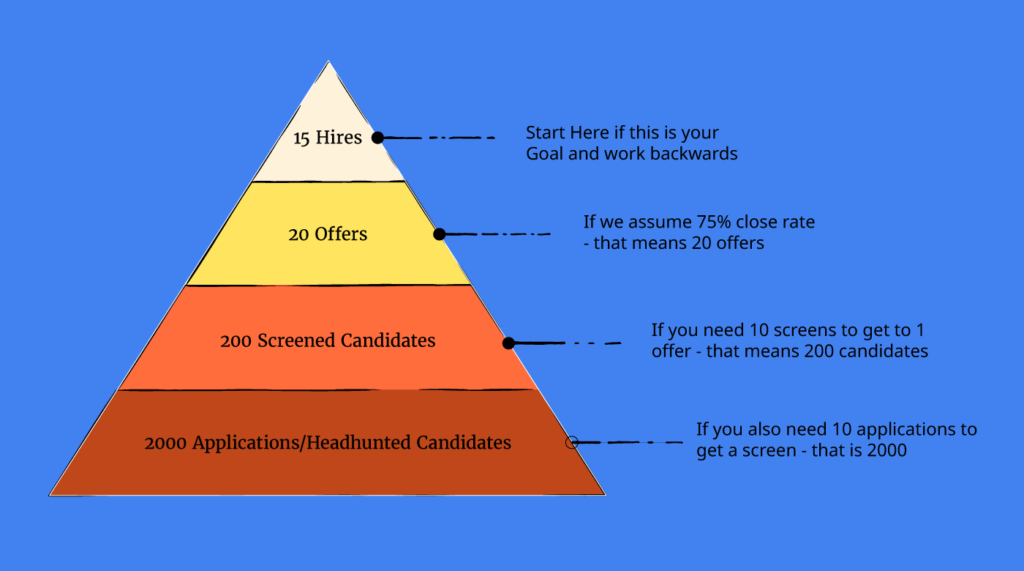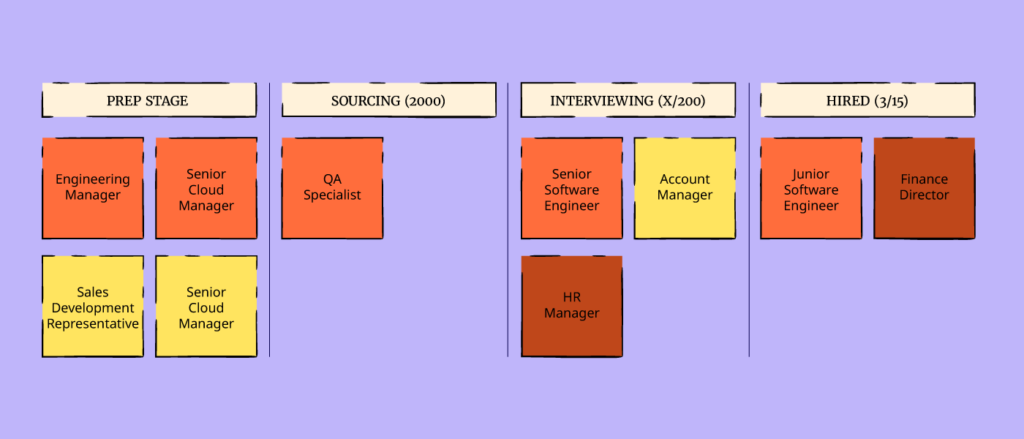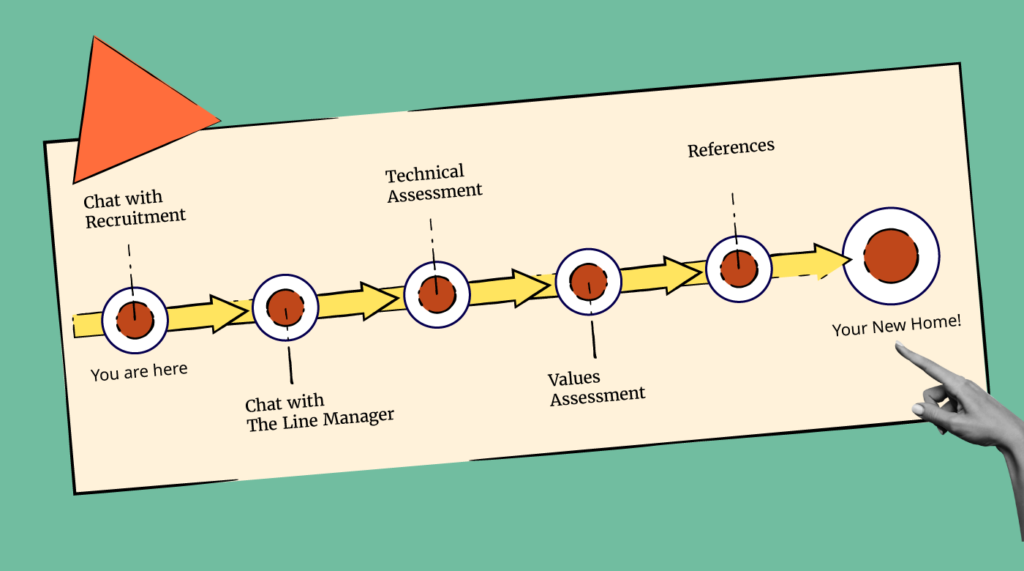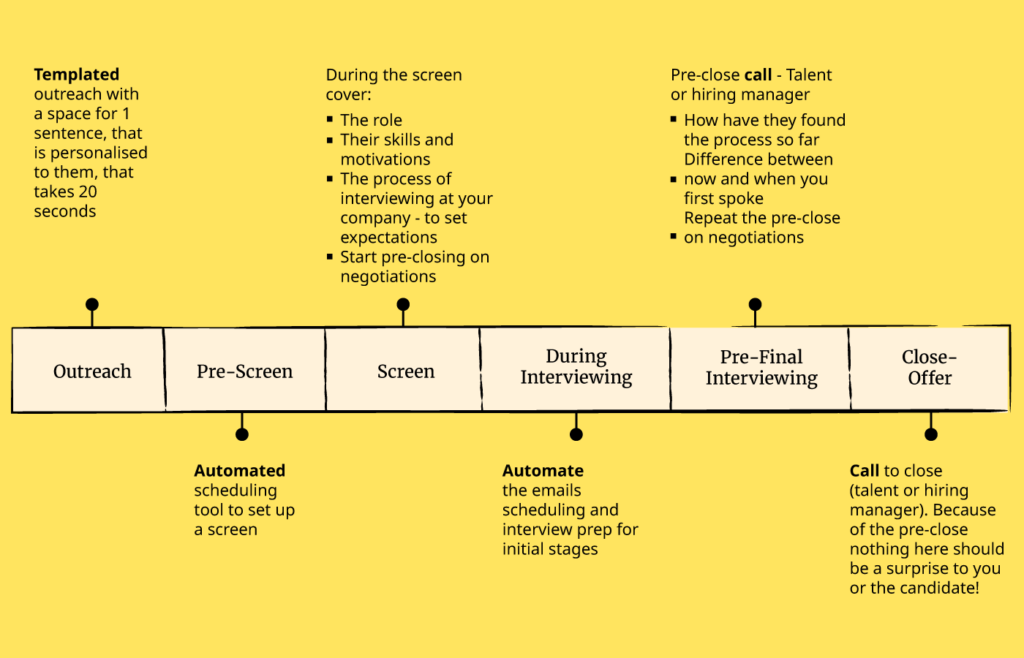Creating a great candidate experience is crucial if you want to hire the right people for your roles.
While the hiring process is an exciting time within an organization, it’s not without its challenges and there is a chance for poor candidate experiences to creep in.
Tasked with bringing in new recruits quickly, most will start talking about automation and mass-scale candidate marketing.
However, you may notice your candidate feedback scores, either in your surveys or on Glassdoor, dropping as a result.
Why?
Because there is the misconception that good candidate experience and hiring fast at scale are mutually exclusive.
But that’s not true!
During my time at a FAANG, I doubled the EMEA headcount whilst simultaneously doubling our candidate feedback score.
This article will explain how my team and I achieved that. But, first up, a quick definition.
What Is The Candidate Experience?
The candidate experience is the experience that candidates have when going through your recruitment process.
It's impacted by factors such as communication, length, difficulty, the quality of interviews, and the efficiency of the process overall.
Why Is The Candidate Experience Important?
Putting the work in to create a positive candidate experience has many benefits including:
- Close more hires
- Receive better quality candidates
- Make better hiring decisions
- Save time and resources internally
- Create a stronger employer brand.
It can even impact employee engagement and retention as your employees will likely pay attention to how you are treating candidates—some of which may be their own referrals!
How To Create A Great Candidate Experience
Here are my strategies for balancing scaling with candidate experience so that you don’t develop the reputation that your company treats candidates like numbers in a Lotto drawing machine.
When looking at the below, it’s important to think about all the touchpoints you will have and how to use those best to further your company’s candidate relationships.
Create a clear talent plan
It seems basic and perhaps less directly related, but starting off with a good talent plan, either at the start of the quarter, year, or even after a funding round, is vital.
Meet all your business leaders and make sure that you schedule a time to talk about the health of their team and how the business aims will impact what resources will be needed.
In my meetings, I always touch upon the following points:
Current skills resource
- What have they been finding easy and what is the current team's strong suit?
- Who are the superstars, is there a potential candidate on the path to being promoted and do we need to backfill?
Skill gaps
- What has the team been struggling with?
- What do they need to hire for vs develop within the team (working alongside learning and development if need be here)?
- Who is underperforming and do we need to start thinking of replacing them?
The job descriptions and structured interviews rely on this to be accurate.
There can often be the urge to reuse old job descriptions, adverts, and interview questions, but I’d encourage you to review them and see if they're really useful for these hires.
It will save you a lot of time down the line if you don’t have to keep revising the job description.
Are we hiring to respond to growth vs hiring to create growth?
Actually a super important distinction. Usually, in teams like product, engineering, or support, it's hiring to respond to growth, whilst commercial teams are there to create growth.
Make sure you speak to leadership so there is a balance between the two types of hiring (revenue-generating roles should almost always be the priority!).
What happens if we don't hire?
This is a great baseline for everyone—Talent and the business—to understand and keep in mind what the impact would be. It will keep Talent searching for the right people and the business leader responsive in making decisions.
Prioritization between roles
If there are multiple roles, and you work with many business partners, you won't be able to fill all the roles at the same time—especially once you start going upwards of 30 roles that each require a lot of sourcing.
Getting the business leader to think about prioritization at the beginning will help you down the line to prioritize for yourself and the Talent Team.
This should mean that, when you’re ready to post a role, you will avoid wasting candidates’ time by engaging them and then freezing the role out of nowhere, or having to keep reworking what the role is throughout the process.
Wasting time is one of the main causes of bad candidate experience, closely followed by frustrating interview processes.
For a deeper dive here, read my article on creating a sustainable hiring plan.
Make it a collaborative endeavor
If any of you have worked for an Amazon company you might be tired of hearing this, so here is a rework: "What would it take to get us there?".
You should have a rough idea of numbers such as closing rates e.g. for your business it may be 4 acceptances for every 5 offers. If you have the exact number for your business then you start working backward—a pyramid instead of a funnel.

This gives a rough idea of the scope of work. Then you can start applying it to your favorite project management tool—Kanban for an overview or Gantt if you have a shorter-term hiring blitz, for example.
Below is an example of a Kanban board of mine with at least rough numbers to aim for.

The next step is super important—share the project map with the hiring manager and the hiring team!
Make this a collaborative endeavor and invite them to participate. That way you can help them have more ownership.
Everyone needs to know what's coming up in the calendar and, if scaling is what the business needs, then everyone needs to absolutely prioritize hiring and that means knowing how much time commitment they will need to give to the recruiting process.
No matter how streamlined your hiring process, it is a time-intensive process. By making hiring more collaborative will help share the load and improve the experience for everyone.
Ensure interviews are rfficient and engaging
When I say efficient, don’t think immediately that the interview process has to be rushed—not at all!
But, if you’re scaling rapidly, you may have to fit in a lot of interviews so making the best out of the time you have is crucial.
Here’s a simple guide on what you need to take a look at to ensure that your candidates have a positive experience.
Step 1: Standardize the interview process.
This will help you to be able to quickly compare candidates with each other and minimise the appearance of some biases.
Step 2: Review the interview questions you ask and when you ask them.
Start with the questions that will give you insights into the skills that you have deemed essential for this role, then work towards the more desirable skills. That way you are moving from qualified candidates to the best candidates.
Make sure they’re well-designed questions that aim to get to the bottom of the experience. If in doubt always ask What, How, and Why.
Tell me about a time when you closed a particularly tough client? What was tough about them? How did you turn the situation around? Why did you use this particular way/information/strategy vs another?
Step 3: Review assessments
Make sure that any assessment is fit for purpose and for the role you have. It needs to be challenging but also not too time-intensive for the candidate to complete or for you to review. You don't want to wander into vampire recruiting territory.
For more depth on focused, engaging interviews check out my article on how to interview someone.
Don’t forget the basics
With all of this talk of efficient interviewing, don’t forget that, when it comes to candidate experience, interviewing is where you can really make it or break it.
This is where candidates spend the most time with you and, even if you haven’t had the time to create a super snazzy careers page with interactivity everywhere, creating a lovely interviewing experience can make up for it.
That’s not to say that the interview should be easy! Most candidates actually prefer interviews that challenge them and make them think about their area of expertise, so the above advice for efficient interviewing still stands.
However, what I want to draw your attention to are the basics that, when you get right probably won’t get rapturous praise, but, if you get it wrong, you will get the deserved criticism.
Always make sure to:
- Introduce yourself and what you do at the company
- If it’s the first interview, introduce the company as well
- Give the context on what you would like to cover in this interview
- Reassure the candidate, whether online or in person that if they need to take a break to grab water or go to the bathroom, they can do so. We are all human
- Make sure you have reviewed their CV beforehand and are armed with questions relevant to them
- Make sure you are on time (even a bit earlier as the host)
- Keep track of time and make sure the candidate gets time to ask questions
- Smile and be curious about the person opposite you!
Seems basic but I still see situations where people forget any number of these things and it always shows.
The above cost nothing to do but can earn you lots of candidate experience points in a sea of employers who are skipping the above but trying to compensate with flashy careers sites.
Set up some automations to help with efficiency
Please note the use of the word "some"!
The usual formula is that the more time a job seeker has spent on interviewing with the recruiter, the more you need to spend on giving them feedback, guidance and attention.
It's a reciprocal relationship, providing great candidate feedback will help them and your team improve.
Will there be 1-2 candidates out of the many who will take advantage?
Yes, but there will be all the others to whom you made a difference by humanizing what can sometimes feel like a very stressful job search.
Modern applicant tracking systems (ATS) and recruiting software have all sorts of automation and here are a few to take advantage of:
- Mass/scheduled emails—can be used for rejections, notifications, or arranging the next steps with candidates
- Careers page management for a great first impression
- Job application questions—frontloading some of the easy “tick-box” questions can help streamline the job application process
- Chatbots that can answer some FAQs from candidates
- Candidate experience surveys—automated at certain points of the interviewing process (my recommendation is at the end).
For example, you can automate the common rejection reasons at CV review—perhaps they don't meet the talent bar or live in the wrong time zone. You can create a few templates to fit those more common reasons.
It takes perhaps 2 extra seconds to find the right reason and, although there is a fear that candidates may get defensive or react and rant about their supposedly negative candidate experience, most of the time rejected candidates will appreciate that you have reviewed their circumstances and reacted to it.
It's a reflection of your company culture and they will also know whether to apply for your next roles too!
You can also automate some emails as you move a potential candidate between stages and follow-ups e.g., in the email to schedule the first stages, you can have a pre-recorded video/Loom (or some other video interview tool) telling them what the next step on their job application journey will encompass.
I’ve found it’s useful to create a visual representation of what the hiring process will look like for them—like a map!

When not to automate
As mentioned above, the more time the job applicant spends interviewing the fewer automated comms they should get.
As soon as they start getting to later stages, start getting on the phone with them and interacting (this could be you or the hiring manager).
You need to start gauging whether the new hire is enthusiastic about the role. Enthusiasm will not be standard across everyone, so make sure you delve deeper into their motivations!
Get curious about people and candidate expectations, they may be your colleague soon! This will also help later at the job offer stage.
Here is an example of a process I run:

Some of you may already be saying “That is a lot of work!” Yes, it is, but scaling will take a lot of work and you cannot automate everything out of human connections.
People hire people, not companies, not algorithms, not Zapier.
Remember non-automated rejections
You will have some job candidates whom you have screened or have gone through X steps of the interview process and did not pass.
Again, the more time they have spent with your company the more attention their rejection will need.
Give proper candidate feedback
Feedback is super important for 2 reasons:
- It gives candidates something to work towards
- It keeps hiring managers and hiring teams accountable for the reasons they’re rejecting candidates. This means no more "they’re not a cultural fit" without explaining why. Sometimes the answers to "why" are not great, so talent acquisition will need to dig in. I hope that you don't dig up something bad, but it is entirely possible!
In EMEA, with the rise of GDPR-driven DSARs, feedback can no longer be denied so candidates can request all their information including their forms and scorecards.
Make sure the hiring teams are aware of that so that they really think about why they are progressing or rejecting someone. Make them present it as a business case.
Even Amazon can no longer say that they do not give feedback—I should know, I was there processing DSARs!
Regularly review candidate feedback and scorecards
Regularly review scorecards from the interviewing panel to check if they are up to par!
Some questions to ask:
- Are they providing a proper business case?
- Is there a clear record of the questions asked and the answers given?
- Is there enough detail?
- Does the final conclusion match the overall feedback or are they being biased somewhere?
All of these will give you an idea of where you might need to step in and course-correct interviewers who are not questioning candidates equally or providing a bad experience.
A three-sentence scorecard from a 45-minute interview makes me question whether someone paid attention in the interview!
You can control a lot about the process, but the interactions with the interview will make up the bulk of the candidate experience. You need to keep tabs and call out where you see that it's not meeting the standards.
When you are speaking to the candidate after interviews, or at the last stage, ask how they found their interview experience so far.
Bonus tips
Remember that people are more likely to leave a negative review than a positive one. Make sure you leave fewer people with a really negative experience and keep on top of feedback.
Will one or two candidates be dropped through the process?
Perhaps—no process is perfect—but you do not want to be known as the company that never gets back to people, only prioritizes candidates who go through the process, and leaves the others ghosted.
Some bonus tips:
- Have fewer meetings: If you have followed the above and talent, the hiring manager and hiring team are on the same page—have fewer meetings. If you have more than 4 roles with the same hiring manager maybe 2 meetings a week are needed but, otherwise, keep it to one.
- Don’t skimp on planning. Spend 10% more time on planning than you think you need to.
- Get on the phone and call the person. I know you think you are super busy and you don't have the time, but if a call takes 3 mins (e.g. a rejection or something)—just do it. If you get down to it you can get through so many calls in half an hour!
- Keep track of recruitment metrics and data. Use one project management board e.g. Kanban as the source of truth of whether you are hitting milestones on time. If not, signal the alarm earlier rather than later and get ready to pull in support from your team or the hiring managers (get them sourcing too!).
Remember, creating a better candidate experience, even through rapidly scaling, doesn’t mean you make rushed decisions or easy interviews. It means you have a smooth hiring process and you are interviewing with a purpose.
Join The Conversation
Good luck with your scaling endeavors, and consider using some recruiting automation tools if you need some help in this area.
If you have any questions or insights to share, find me in the People Managing People Community—a supportive community of HR and business leaders sharing knowledge and ideas to help you progress in your career and make a bigger impact in your organization.



